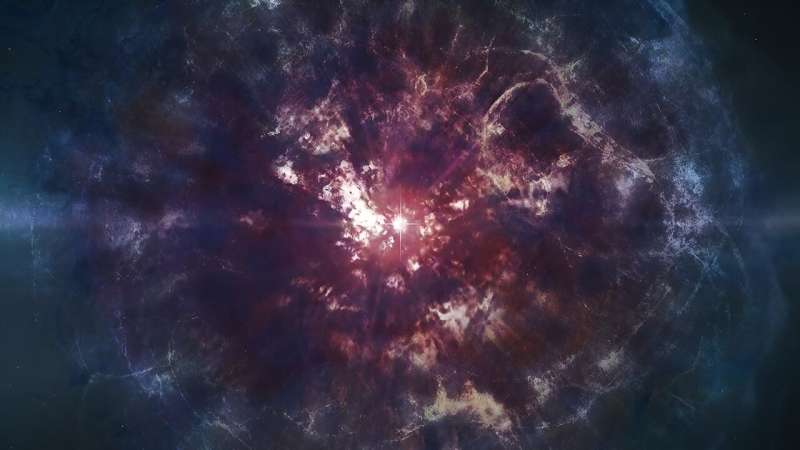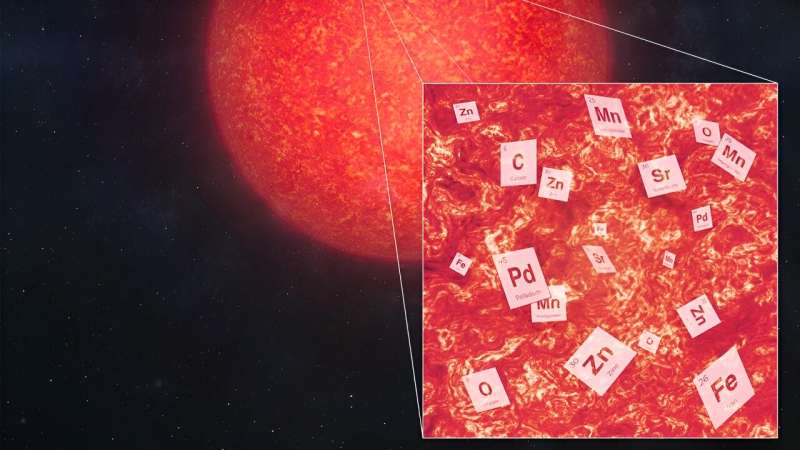This article has been reviewed according to Science X's editorial process and policies. Editors have highlighted the following attributes while ensuring the content's credibility:
fact-checked
peer-reviewed publication
trusted source
proofread
Discovery of unusual star may change our picture of how stars explode and elements are made

Scientists have found a star unlike any other one recorded—which may change our understanding of how stars die.
This unusual star, 13,000 light-years away, has an elemental makeup that suggests it was formed in the aftermath of a more massive star exploding in a way that no existing theory seems to explain. According to everything else we know, the original star should have turned into a black hole instead.
The discovery may rearrange our picture of how stars explode and how some of the heavier elements are made. It also helps us better understand what the first generation of stars in the universe may have looked like.
"This opens a new window into how the most massive stars in the universe die—and thus also how the elements in the universe are made," said Alex Ji, assistant professor of astronomy and astrophysics at the University of Chicago and first author on the paper posted to the arXiv preprint server and scheduled to be published Jan. 22 in The Astrophysical Journal Letters.
'Everything about it was weird'
Ever since Subrahmanyan Chandrasekhar first showed that stars don't live forever but can die, scientists have been unraveling the ways this can happen with different kinds of stars.
Today, scientists think that not only do stars explode all the time, but that this is one of the main ways that all of the elements in the universe heavier than hydrogen and helium were created.
These explosions, also called supernovae, are so powerful that they can recombine elements to create new ones. In the aftermath, new stars eventually form out of the cloud of elements left behind.
Scientists can tell what kind of elements are in a star by looking at the light it emits, so by carefully measuring the makeup of many stars, they can reconstruct the types of explosions that likely preceded them.
But while poring over data from the Sloan Digital Sky Survey, Ji and his team noticed a star that seemed to have unusual readings. They used the Magellan Telescope in Chile to take a closer look. Right away, they saw it was different from any star previously recorded.
"Everything about it was weird," Ji said. "Elements that you'd normally have more of, like carbon and sodium, are very low, whereas other elements like iron and zinc are very high."
This points to a fundamental difference in how this star came to be. It indicates it was born in the aftermath of a very different kind of explosion than scientists have previously catalogued.

"We looked through so many types of supernova models, but nothing quite matched," said Sanjana Curtis, formerly a postdoctoral researcher at UChicago and now at the University of California Berkeley, and the second author on the paper.
In particular, the amount of iron suggests that the star that exploded was quite massive—probably about 80 times the mass of our own sun. "But according to the best theory we have now, a star with that mass should turn into a black hole instead of exploding," said Curtis. "So there's no existing model yet for how this could have happened.
"It hints that we may need better theories of supernova physics, and maybe even better theories for stellar evolution itself," she said.
Stellar archaeology
As best as the scientists can tell, the parent star probably belonged to one of the first generations of stars in the universe. After it exploded, the debris left behind eventually coalesced into a second generation of stars, one of which fell into the Milky Way, where Ji, Curtis, and their colleagues measured its makeup.
What would this explosion have looked like? All we can tell is its elemental makeup, but Ji thinks this explosion probably looked distinctively asymmetric when it happened. "One thing we think drives massive stars to explode is energy going off in jets," he explained.
One thing is for sure, though—it was a very powerful explosion.
"We think it's possible it could have been energetic enough to blow up an entire galaxy by itself, though a small galaxy," said Ji.
In addition to suggesting a new type of supernova, the discovery offers a tantalizing hint at that lost first generation of stars in the universe.
"Those early stars died very quickly," said Curtis. "Even the James Webb Space Telescope, the most powerful telescope we have, can't see those earliest stars themselves, so that's why we look at this second generation. It's like archaeology for stars."
If scientists can find more of these unusual second-generation stars, it could help prove theories about that first generation of stars and how massive they were.
The scientists said that they began calling the oddity the "Barbenheimer star," after the popular portmanteau for the double feature of the movies Barbie and Oppenheimer, which both opened this summer at the same time the scientists were puzzling over the star that exploded. "It fits 'Barbie' because it's spectacular, and 'Oppenheimer' because like nuclear fission, it creates new elements," said Ji.
More information: Alexander P. Ji et al, Spectacular nucleosynthesis from early massive stars, arXiv (2024). DOI: 10.48550/arxiv.2401.02484
Journal information: arXiv , Astrophysical Journal Letters
Provided by University of Chicago





















